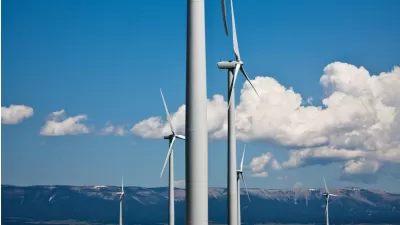No cause has yet been attributed to California's deadliest wildfires, but the connections to fallen power lines and exploding transformers, maintained by PG&E, have been exposed in a series of reports by the Bay Area News Group.

On Oct. 11, the California Department of Forestry and Fire Protection (CAL FIRE) "said that investigators have started looking into whether toppled power wires and exploding transformers Sunday night [Oct. 8] may have ignited the simultaneous string of blazes," report Matthias Gafni and Emily DeRuy in The Mercury News.
The acknowledgment followed publication of a review by the Bay Area News Group of Sonoma County firefighters’ radio transmissions in the fires’ infancy that found that there were numerous downed and arcing wires. In the first 90 minutes Sunday night, firefighters were sent to 10 different spots where problems had been reported with the area’s electrical infrastructure. The crews reported seeing sparking lines and transformers.
PG&E acknowledges there were troubles with its equipment Sunday night, but says blaming the utility’s electrical system for the fires at this point would be “highly speculative.” It has labeled the conditions in the first hours of the fires a “historic wind event.”
Mapping and regulations
Gafni and DeRuy report that a bill approved last year, SB 1463: Electrical lines: mitigation of wildfire risks, by Sen. John Moorlach, R-Costa Mesa, "would have required the state to identify the places most at risk for wildfires and would have required the [California Public Utilities Commission] CPUC to beef up plans to prevent fires sparked by power lines — including moving lines underground if necessary."
Gov. Jerry Brown (D) vetoed the bill, claiming it was "unnecessary" because "the Commission and CalFire have been doing just that through the existing proceeding on fire-threat maps and fire-safety regulations."
Fire hazard mapping, it turns out, is key to determining which transmission wires are most at risk. Gafni reports on Oct. 22 that the CPUC has been working to update the fire maps for 10 years. Worse yet, the state's electric utilities have "helped stall the effort."
A review of the mapping project by the Bay Area News Group shows that utilities have repeatedly asked to slow down the effort and argued as recently as July that, as PG&E put it, certain proposed regulations would “add unnecessary costs to construction and maintenance projects in rural areas.”
Gafni also reports that the Northern California wildfires have "killed at least 42 people and destroyed more than 5,000 homes and businesses."
Litigation
DeRuy reports on Oct. 18 that a Santa Rosa couple, Wayne and Jennifer Harvell, who lived in the devastated Coffey Park neighborhood, is the first to sue PG&E over their role in the fires.
The Harvells allege that the utility company failed to adequately maintain power lines, leading to the destruction of their Coffey Park house and at least 1,000 others in the neighborhood as the Tubbs fire consumed the region.
A table [jpg] showing notable wildfires caused by power lines since 1923, including acres burned and structures destroyed, was provided by state Sen. Jerry Hill (D-San Mateo), who has been both a CPUC and PG&E watchdog since a PG&E natural gas main exploded in San Bruno, killing eight people.
Hat tip to David McCoard.
FULL STORY: Wine Country fires: Gov. Brown vetoed 2016 bill aimed at power line, wildfire safety

Study: Maui’s Plan to Convert Vacation Rentals to Long-Term Housing Could Cause Nearly $1 Billion Economic Loss
The plan would reduce visitor accommodation by 25,% resulting in 1,900 jobs lost.

North Texas Transit Leaders Tout Benefits of TOD for Growing Region
At a summit focused on transit-oriented development, policymakers discussed how North Texas’ expanded light rail system can serve as a tool for economic growth.

Why Should We Subsidize Public Transportation?
Many public transit agencies face financial stress due to rising costs, declining fare revenue, and declining subsidies. Transit advocates must provide a strong business case for increasing public transit funding.

How to Make US Trains Faster
Changes to boarding platforms and a switch to electric trains could improve U.S. passenger rail service without the added cost of high-speed rail.

Columbia’s Revitalized ‘Loop’ Is a Hub for Local Entrepreneurs
A focus on small businesses is helping a commercial corridor in Columbia, Missouri thrive.

Invasive Insect Threatens Minnesota’s Ash Forests
The Emerald Ash Borer is a rapidly spreading invasive pest threatening Minnesota’s ash trees, and homeowners are encouraged to plant diverse replacement species, avoid moving ash firewood, and monitor for signs of infestation.
Urban Design for Planners 1: Software Tools
This six-course series explores essential urban design concepts using open source software and equips planners with the tools they need to participate fully in the urban design process.
Planning for Universal Design
Learn the tools for implementing Universal Design in planning regulations.
City of Santa Clarita
Ascent Environmental
Institute for Housing and Urban Development Studies (IHS)
City of Grandview
Harvard GSD Executive Education
Toledo-Lucas County Plan Commissions
Salt Lake City
NYU Wagner Graduate School of Public Service




























